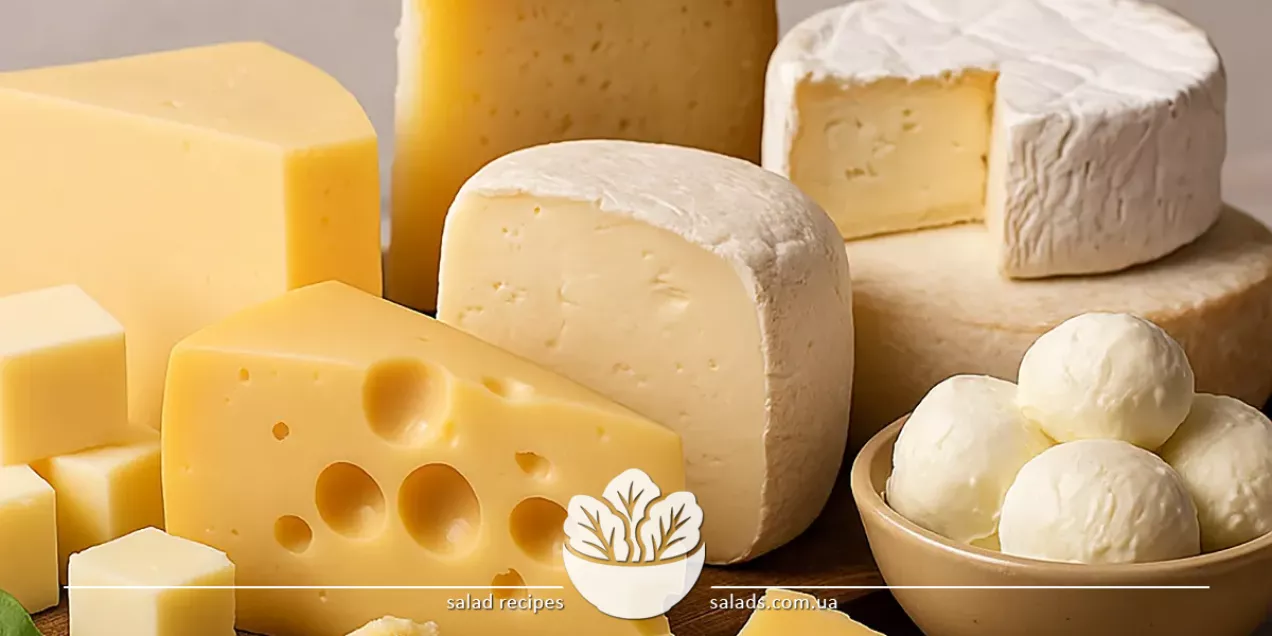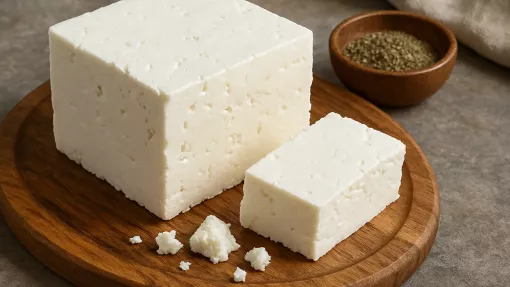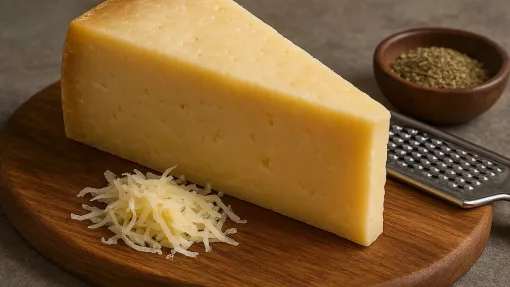Cheese

Cheese is one of the oldest and most universal categories of food made from milk. This group includes numerous varieties – from soft and creamy to aged hard types that can be stored for years. Cheese differs in flavor, texture, maturation process, and region of origin, allowing it to blend harmoniously into recipes from around the world. It is used in appetizers, main dishes, baked goods, and even desserts. The Dairy Products category encompasses a wide range of ingredients, but cheese plays a particularly important role due to its high nutritional value and rich flavor characteristics.
Different Types of Cheese
Soft and Fresh Cheeses: Delicate Texture and Neutral Flavor
Soft and fresh cheeses hold a special place in cooking thanks to their gentle texture, mild taste, and versatility. This group includes ricotta, mozzarella, cream cheese, bryndza, young goat cheese, and other similar products that do not undergo long aging. They are commonly used in cold appetizers, salads, sandwiches, and even desserts. These cheeses typically have high moisture content, soft consistency, and a neutral flavor that pairs well with both savory and sweet ingredients. In addition to flavor flexibility, soft cheeses offer dietary advantages – they are easier to digest and contain less salt and fat compared to aged varieties. When combined with vegetables, grains, or fruits, these cheeses can serve as the base for a complete breakfast or a light dinner. For example, fresh cheese paired with olives or basil makes a classic Mediterranean salad.
In global cuisines, fresh cheeses are often used with local specialties – from French chèvre to Georgian suluguni. These cheeses go well with cold-pressed oils, such as olive oil, which enhances their natural flavor and aroma. They are also suitable for pairing with vegetable sides or toasted bread. Due to their simplicity, soft cheeses are widely used in both home and restaurant cooking – especially where lightness, freshness, and speed are key in meal preparation.
Hard and Aged Cheeses: Deep Flavor and Culinary Versatility
Hard and aged cheeses are the result of long-term maturation, during which the product develops a firm texture, strong aroma, and rich flavor. These cheeses can be stored for months or even years, developing complex notes – from nutty to caramel. The most well-known representatives of this category include Parmesan, Grana Padano, Cheddar, Emmental, Gouda, Maasdam, Pecorino, and others, all of which are valued in sliced or grated form. These cheeses are ideal for hot dishes, as they melt well, forming a crispy crust or a stretchy cheese layer. They are used in pasta dishes, casseroles, pizza, lasagna, and meals with meat, grains, or legumes. For instance, the classic combination of grated hard cheese with rice is used in risotto and other Italian recipes.
Aged cheeses offer high levels of protein, calcium, and vitamin B12. At the same time, due to lower moisture, they contain more fat and salt, which should be considered in a balanced diet. In gastronomy, these cheeses are often featured on cheese boards, paired with fruits, nuts, or honey. For example, thin slices of hard cheese go perfectly with olives or grapes, especially alongside dry wine. Hard cheeses can also serve as a natural salt substitute in dishes, adding depth without extra seasoning. Thanks to their longevity, complex flavor, and nutrition, aged cheeses remain a staple in both everyday and festive cuisine.
Brined Cheeses: Culinary and Cultural Versatility
Brined cheeses form a distinct group of products that are aged and stored in a salt solution. This category includes bryndza, suluguni, feta, mozzarella in brine, and other similar types. These cheeses have a dense yet elastic texture, a salty taste, and a characteristic milky aroma. Thanks to the brine, they retain moisture even after prolonged storage, making them especially appealing in summer salads, appetizers, and baked goods. In cooking, brined cheeses are widely used as key ingredients in Mediterranean, Caucasian, Middle Eastern, Balkan, and Ukrainian cuisines. They pair well with fresh vegetables, roasted eggplants, fresh bread, and olives. For example, cubes of feta with fried pork and tomatoes create a protein-rich and well-balanced dish. In Balkan cuisines, bryndza is added to pies, while suluguni is used in khachapuri or meat-based hot dishes.
The saltiness of brined cheeses makes them excellent natural seasonings, so dishes with them often require no extra salt. With relatively low fat content (in some types) and moderate calorie levels, these cheeses are a popular choice for healthy diets. They are also convenient for sandwiches or baking in the oven – cheese keeps its shape but gains a pleasant elasticity. In many recipes, brined cheeses are essential not only for their flavor but also for their physical properties – they do not melt completely, helping retain the structure of a dish. This makes them versatile ingredients in many world cuisines and ensures wide culinary use in any season.
Mold-Ripened Cheeses: Sophisticated Flavors for Connoisseurs
Mold-ripened cheeses are one of the most refined categories, featuring products with distinctive flavor and delicate aroma. They are divided into two main types: cheeses with white mold on the surface (such as Camembert and Brie) and cheeses with blue mold inside (such as Roquefort, Gorgonzola, Stilton). The mold is not only safe but also beneficial – it helps develop the cheese's signature flavor, encourages fermentation, and creates a unique texture. These cheeses are produced using special techniques with cultures of Penicillium camemberti or Penicillium roqueforti. They mature in controlled environments, developing either a soft, creamy consistency or a crumbly and grainy texture, depending on the type. The visual appearance – from white fluffy rinds to blue-green veins – signals the cheese’s craftsmanship and quality.
Mold-ripened cheeses pair wonderfully with crusty bread, nuts, grapes, and honey. They are frequently used in fine cuisine – salads with pears, sauces for pasta or meat, and cheese platters. For example, a slice of Brie with walnuts and honey is a classic elegant appetizer. These cheeses also possess notable culinary properties: when heated, they become even softer, forming creamy bases for sauces or casseroles. Despite their strong flavor, moldy cheeses are popular among gourmets, and moderate consumption enriches the diet with vitamins, protein, and beneficial bacteria. These cheeses are not just ingredients – they are part of culinary tradition and culture.
Processed, Smoked, and Unconventional Cheeses: Modern Takes on Tradition
Beyond traditional categories, processed, flavored, and experimental cheeses occupy a significant niche. This includes processed cheese, smoked types, and cheeses with added spices, herbs, nuts, or even fruit. Processed cheeses are made by melting one or more types of cheese with added cream, salt, stabilizers, and emulsifiers. Their main advantages are long shelf life, soft texture, and ease of use. Smoked cheeses have a pronounced aroma and a distinctive yellow-brown rind. They are produced through cold or hot smoking, which gives them a rich flavor that pairs well with meats, vegetables, and baked goods. In home cooking, they are often used as fillings for pastries or ingredients in appetizers. These cheeses also go well with chicken eggs in hot sandwiches or casseroles.
Unconventional cheeses with flavorings reflect a modern approach to cheesemaking. Ingredients may include aromatic herbs, chili, garlic, cranberries, truffles, or basil. These cheeses offer not only bold flavor but also visual appeal, especially on cheese platters. They are often used in recipes that aim to emphasize aroma and create unexpected taste combinations. Processed and flavored cheeses are particularly handy for quick meals – they melt evenly, have a smooth consistency, and work well as spreads, in sauces, soups, or even omelets. Their popularity comes from accessibility, versatility, and readiness to eat without further preparation. In restaurants and home kitchens alike, these cheeses help diversify recipes without sacrificing quality or flavor harmony.

